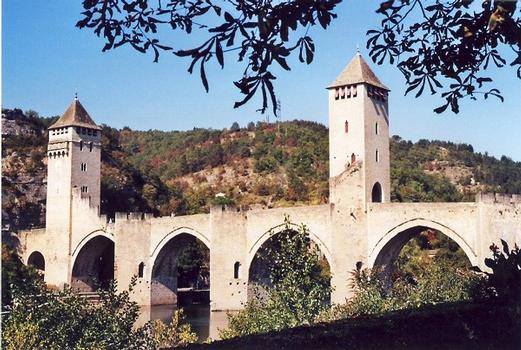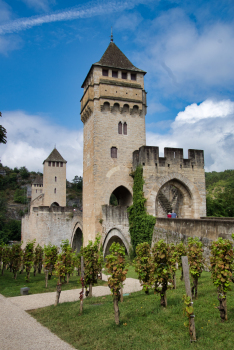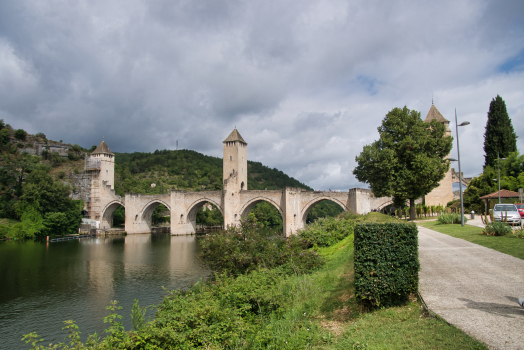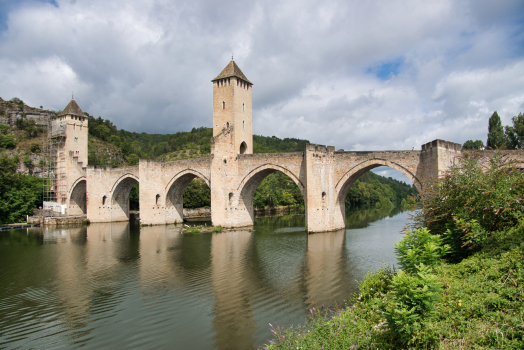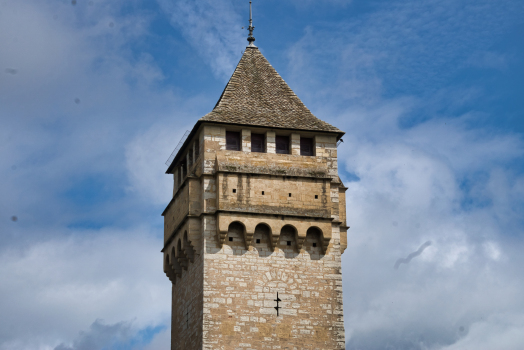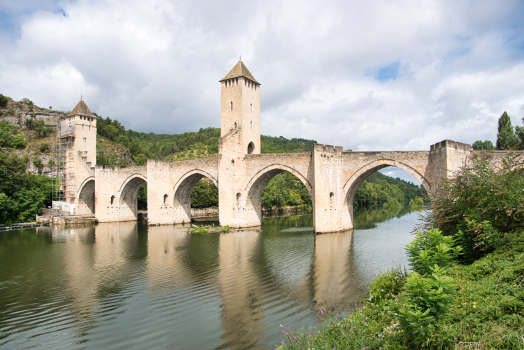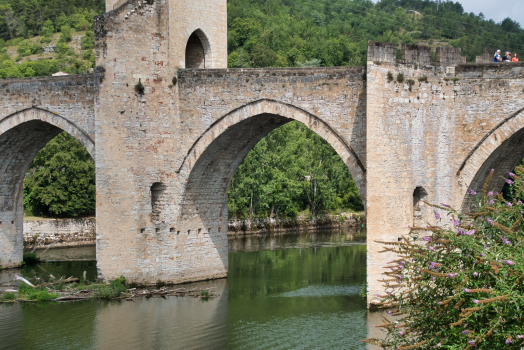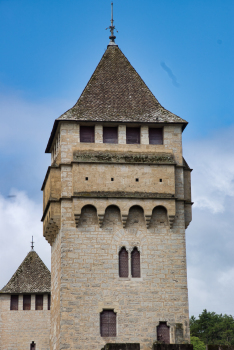General Information
| Name in local language: | Pont Valentré |
|---|---|
| Beginning of works: | 17 June 1308 |
| Completion: | 1378 |
| Status: | in use |
Project Type
| Structure: |
Pointed arch bridge |
|---|---|
| Function / usage: |
Road bridge |
| Material: |
Masonry bridge |
| Plan view: |
Structurae Plus/Pro - Subscribe Now! |
| Function / usage: |
Watch tower |
| Material: |
Load-bearing masonry tower Structurae Plus/Pro - Subscribe Now! |
Awards and Distinctions
| 1998 |
part of an ensemble
for registered users |
|---|---|
| 1840 |
for registered users |
Location
| Location: |
Cahors, Lot (46), Occitanie, France |
|---|---|
| Crosses: |
|
| Above of: |
Valentré Lock
|
| Coordinates: | 44° 26' 42.36" N 1° 25' 54.01" E |
Technical Information
Dimensions
| width | 5 m | |
| rise | 8.70 m | |
| total length | 138 m | |
| span lengths | 6 x 16.50 m | |
| number of spans | 6 | |
| towers | height | 40 m |
Materials
| tower |
stone
|
|---|---|
| arches |
stone
|
Chronology
| 30 April 1306 | Decision made to build the bridge |
|---|---|
| 17 June 1308 | Maître G. de Sabanac, first consul, lays the first stone. |
| 1350 | Bridge enters use. |
| ca. 1380 | All works finished after 1380. |
| 1867 — 1879 | Careful reparation and reconstruction. |
Notes
The following legend is told about the bridge: Due to slow progress in construction, the master builder made a pact with the devil who was supposed to help him. As he wanted to save his soul, he made a bet with the devil just before completion to bring him water for the last batch of mortar in a large sieve. The devil of course was unable to provide the water in the sieve and lost the bet. In revenge, the devil broke a stone from a corner of the center tower every night that had to replaced the following day every time.
Architect Paul Gout, in charge of the restoration of the bridge was told about this legend which the locals used to explain the missing stone in the tower. The architect asked sculptor C. A. Calmon to make a stone sculpture of the devil pulling a stone out of the wall. That sculpture was then placed where the stone was missing. Since then the bridge is also called the "Devil's Bridge" or the tower is called "Satan's Tower".
Excerpt from Wikipedia
The Pont Valentré (French pronunciation: [pɔ̃ valɑ̃tʁe]) (Occitan:Pont de Balandras; English: Valentré Bridge) is a 14th-century six-span fortified stone arch bridge crossing the Lot River to the west of Cahors, in France. It has become a symbol of the city.
After the decision was made to build it on 30 April 1306, construction began on 17 June 1308. It was built between 1308 and 1378 with six Gothic arches and three square bridge towers. It opened for use in 1350. It was originally fortified at both ends, but the western tower has not survived.
A major restoration was performed from 1867 to 1879 by Paul Gout.
The legend of the Pont Valentré
The construction of the bridge lasted 70 years (1308 to 1378). In local folklore it is said that the foreman, exasperated by the slow pace of the work, signed a pact with the Devil. In the pact the Devil promised to use his skills expedite the work and, if he carries out all of the foreman's orders, then his (the foreman's) soul would be forfeit.
Having seen the bridge built on time, the foreman regrets his decision and issues a final order to the devil to go and collect water for the other workers using a sieve. In revenge for having been tricked, the Devil sends a demon each night to loosen the final stone in the central tower (known as the Devil's Tower) to ensure that the bridge is never finished and must be repaired each day
During the restoration of the bridge in 1879, the architect Paul Gout inserted a stone bearing the sculpted image of an imp into the central tower. As a result, according to the updated legend, every time the Devil checks to see that his vandalism has been carried out he is confused into thinking that the stone image is one of his demons tasked with dismantling the bridge.
Text imported from Wikipedia article "Pont Valentré" and modified on July 22, 2019 according to the CC-BY-SA 4.0 International license.
Participants
Relevant Web Sites
Relevant Publications
- (2002): Bridges that Changed the World. Prestel, Munich (Germany), pp. 36-37.
- (1994): Brücken / Bridges. Ästhetik und Gestaltung / Aesthetics and Design. 4th edition, Deutsche Verlags-Anstalt, Stuttgart (Germany), pp. 72-73.
- (2002): Brücken, die die Welt verbinden. Prestel, Munich (Germany), pp. 36-37.
- (1989): Cahors, le pont Valentré. Presented at: Congrès archéologique de France, 147ème session, Quercy, 1989, pp. 99-108.
- : Cahors. Le pont Valentré. Presented at: Congrès archéologique de France, 100ème session, 1937. Figeac, Cahors, Rodez, pp. 270-276.
- About this
data sheet - Structure-ID
20000635 - Published on:
25/03/2000 - Last updated on:
04/08/2023

